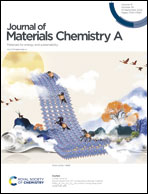NH-rich red poly(heptazine imide) nanoparticles with simultaneously promoted exciton dissociation and activated n → π* electronic transition for boosted photocatalytic H2 generation†
Abstract
The efficiencies of visible-light utilization and exciton dissociation are crucial for the photocatalytic H2 evolution of poly(heptazine imide) (PHI), but simultaneously achieving both goals still presents a challenge. Herein, we firstly synthesized NH-rich red PHI nanoparticles (RPHI NP) with tunable n → π* electronic transition by calcining melamine using a KCl/KSCN molten system. The small particle size (about 50 nm in diameter) promotes charge separation via shortening the electron and hole transfer distance. Moreover, the n → π* electronic transition can be controllably regulated by changing the KSCN dosage, which remarkably broadens the optical response range to 750 nm. Collaborative optimization of the two enables RPHI1 NP to exhibit 25 times higher photocatalytic H2 evolution reaction (HER) rate than bulk PHI under visible-light irradiation (λ > 510 nm). This work details the simultaneous achievement of the optimization of charge separation and optical absorption of PHI via the synthesis of red PHI nanoparticles, which paves the way for developing advanced PHI materials.



 Please wait while we load your content...
Please wait while we load your content...